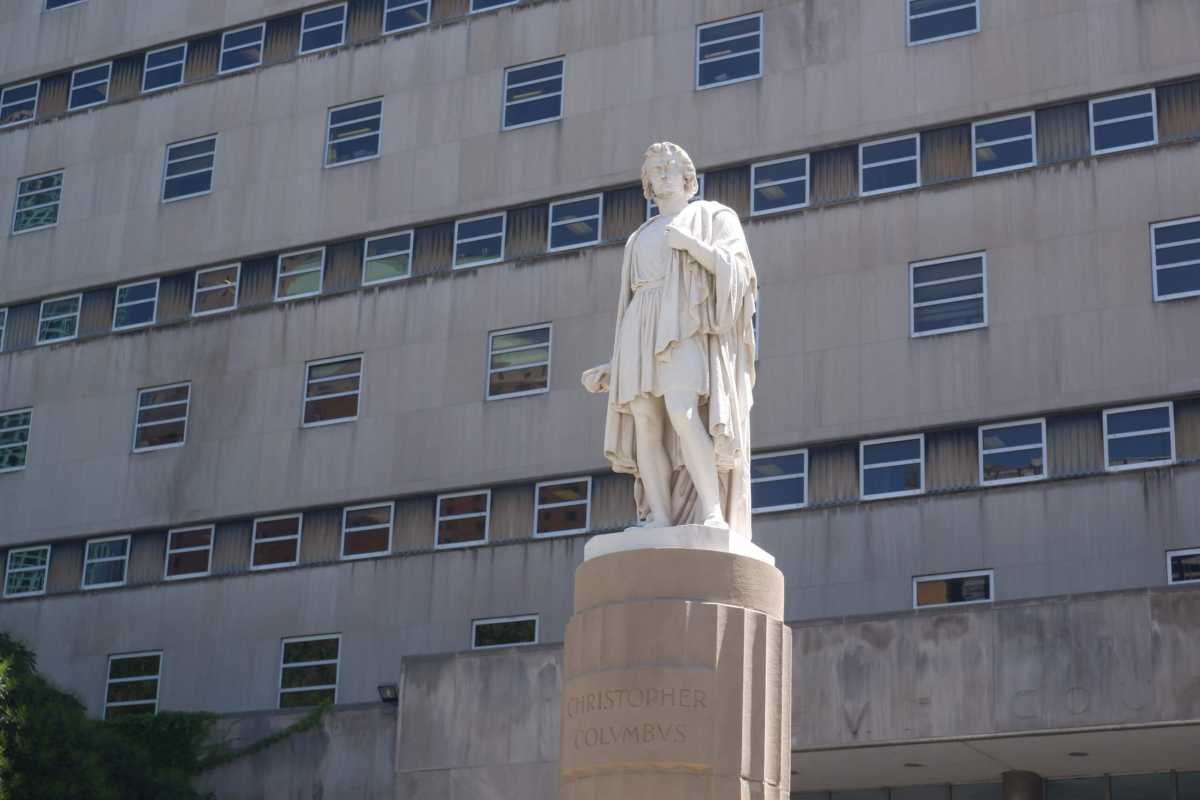Downtown Brooklyn civic gurus called for the removal of the local Christopher Columbus statue outside the Supreme Court Building on Adams Street — saying the 15th century European explorer’s history of exploitation and atrocities against indigenous people should not be publicly commemorated in America’s Downtown.
“I think statues are a representation of our values and it’s quite clear if we know the real history here — which is real — this is not a value of probably anybody here,” said Nicholas Ferreira at a virtual meeting of Community Board 2’s Parks committee on Monday.
The panel voted to send a letter to the Parks Department in support of removing the marble monument after a request by the aptly-named activist group Take Down Columbus NYC — a 10-member organization of educators and social workers that hold regular talks about the colonist’s history and advocates for removing effigies to the colonist around the Five Boroughs.
One member of the organization gave the committee a presentation about how Columbus’s history has been revised to obscure the brutal acts that his men committed against natives when they crossed the Atlantic Ocean more than 500 years ago.
“The narrative of Columbus often goes that in 1492 he sailed the ocean blue, that he was a lost child, a curious wanderer taking on the noble and courageous task of discovering the New World,” said Victoria Vasquez. “However the truth is that Columbus was a capitalist through and through. He did not go into the New World with a curious lens but with a goal to hunt and claim anything he could for material gain.”
Vasquez referenced letters from Columbus boasting about offering enslaved girls for his troops to rape, along with accounts from his fellow travelers about how his men slaughtered native men, women, and children.
Several meeting attendees voiced their support for ridding the square of its controversial tribute, with one indigenous Kings Countian saying its presence tarred the local court houses.
“I am Native American and Black on my father’s side, I am Latino on my mother’s side,” said George Scott. “I am a Brooklynite who has to do jury duty at that court house…but I have to go and serve justice in a building that right in front of it has a criminal, a historically awful criminal — it is triggering every time I walk by it.”
The 7-foot marble statue atop an 11-foot pedestal was sculpted by Emma Stebbins in the 1860s, but lingered in a Central Park maintenance yard until 1934, when officials installed it in Manhattan’s Chinatown, according to the Parks Department’s website.
In 1971, following the renaming of the southern part of Cadman Plaza in honor of Columbus, the administration of Mayor John Lindsay installed the statue at its current location with support from the Italian Historical Society of America.
The issue gained more momentum over the summer, when an anonymous online petition launched to remove the statue in the wake of Black Lives Matter protests and the killing of 46-year-old George Floyd by a former Minneapolis police officer, leading to activists calling for the removal of controversial historical monuments around the country — particularly generals of the Confederacy and other colonial figures.
Following the deadly 2017 white supremacist “Unite the Right” rally in Charlottesville, Virginia, Mayor Bill de Blasio launched a commission to review “symbols of hate” across the city, including statues of Columbus.
Officials ultimately decided to retain the sculptures, amid fierce defenses from Italian Americans, including Gov. Andrew Cuomo — although they offered to place new historical markers giving historical context for such monuments.
The Italian Historical Society and other groups, such as the Bath Beach-based Federation of Italian American Organizations of Brooklyn, came out in defense of the monument, saying calls for removal were an “attack” on history.
The Federation’s president, Jack Spatola, told Brooklyn Paper that the city should keep the statue as a representation of Italian-American achievement.
“During the past century, the statue of Cristoforo Colombo has represented and continues to represent the great achievements and rich contributions of Italian Americans to our American society,” Spatola said in a statement. “The Federation supports keeping the statues of Cristoforo Colombo and joining all efforts to recognize the great achievements and contributions of all other members of the great American society.”
One community board member said activists needed to hold their horses and allow for a broader discussion with various Brooklynites, including the Italian-American supporters of Columbus.
“I think a very broad community has to take part in this discussion, this cannot be just you know, ‘We got together after a year in a group meeting of 15-to-20 people in a room and this is our proposal, take down the statue,'” said Andrew Lastowecky. “Yes although it maybe should be considered for taking down, but I think the discussion has to be a little bit more broader in order to fully completely get to the bottom of this.”
Several countered that the meeting was public forum enough, including one audience member, who said he was of Sicilian heritage and argued that Columbus misrepresents the Italian-American immigrant experience.
“He was chosen as an Italian-American symbol but he essentially represents nothing about our collective experience of human beings working for a living in New York City for the last 100 years,” said Dan Raymond. “Just take it down, doesn’t matter what we do with it, who we replace it with or the minute details of, you know, we don’t want a plaque, the details don’t matter, we want it down.”
The committee voted in favor of sending a letter to the Parks Department with 11 Yes votes, none against, and five abstentions. The letter will go before the board’s Executive Committee on Dec. 28 for final approval before they can send it to the agency.
A Parks spokeswoman said the agency will review the letter once they get it.
“We recognize the importance of the continued contemporary reevaluation and dialog regarding historical figures and related public tributes to them, and will review the letter once received,” Megan Moriarty said in a statement.





















